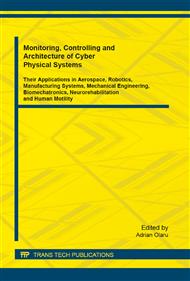[1]
J. Hajkova, English-Czech and Czech- English ecology and protection of environment dictionary, Lexicon Pragensia. 1998 [In Czech].
Google Scholar
[2]
D. Vališ, Z. Vintr, J. Malach, Selected aspects of physical structures vulnerability – state-of-the-art. Eksploatacja i Niezawodnosc – Maintenance and Reliability, 2012, vol. 14, no. 3, pp.189-194. ISSN 1507-2711.
Google Scholar
[3]
Tbilisi Declaration 1977 [online]. Available at: http: /www. gdrc. org/uem/ee/tbilisi. html.
Google Scholar
[4]
Z. Votruba, M. Novak, NOVÁK, M. and VOTRUBA Z. Human Factor Influencing the Reliability of Car Driving. In Sborník z konference Opotřebení, spolehlivost, diagnostika 2007, Brno, 2007, č. 1, pp.197-204. ISBN 978-80-7231-294-8.
Google Scholar
[5]
P. Droppa, Application of thermal protection of military vehicles. In: International Conference on Military Technologies. University of Defence, Brno, 2009, pp.47-54. ISBN: 978-80-7231-649-6.
Google Scholar
[6]
L. J. Mengel, Research of acoustic ranging signal' TOA estimate algorithm in wireless sensor network In: 7th International symposium on test and measurement, pp.727-730, China 2007, ISBN: 978-988-99684-3-4.
Google Scholar
[7]
H. Dudycha et al, Technical equipment for human detection working in the ELF zone. Patent No. 17993, Industrial ownership office, Praha (2007).
Google Scholar
[8]
V. Klaban et al: Equipment for simplification of the passive detection of the humans behind the block. Patent No. 17504, Industrial ownership office, Praha (2007).
Google Scholar
[9]
S. H. Chang, M. Wolf, Human Detection and Tracking via Ultra-Wideband (UWB) Radar In: IEEE International Conference on Robotics and Automation ICRA, pp.452-457, USA 2010, ISSN: 1050-4729.
DOI: 10.1109/robot.2010.5509451
Google Scholar
[10]
E. Cardis, M. Vrijheid, M. Blettner, Risk of cancer after low doses of ionising radiation: retrospective cohort study in 15 countries. BMJ 331 (7508): 77. (July 2005). http: /www. bmj. com/content/331/7508/77. long.
Google Scholar
[11]
World health organization. Global status report on road safety: time for action. Geneva, 2009. ISBN 978-92-4-156384-0.
Google Scholar
[12]
S. Cornak, A. Jarosova, L. Puskarova, Výskyt esterů kyseliny ftalové v potazích na volant vozidel. Chemické listy, 2013, č. 107, s. 960-962. ISSN 0009-2770.
Google Scholar
[13]
V. Fleknova, Air conditioning. Praha : [s. n. ], 2008. 75 s [In Czech].
Google Scholar
[14]
P. W. Mullen, Modern Gas Analysis, Interscience, London (1955).
Google Scholar
[15]
D. Vališ, Z. Vintr, J. Chaloupka, Conditions for the Accelerated Test of Electronic Parts of Military Vehicles. Transport means, 2012, no. 1, pp.294-297. ISSN 1822-296X.
Google Scholar
[16]
H. J. Bretschger, The curve rate of human breathing (Pneumotachogramm). In: Pflugers archiv fur die gesamte psychologie des menschen und der tiere, Vol. 210, pp.134-148, New York 1925, IDS Number V17UQ [In German].
DOI: 10.1007/bf01722879
Google Scholar
[17]
Silbernagl, S. a kol.: Atlas fyziologie člověka, Grada Publishing, 3. české vydání, Praha 2004. s. 108.
Google Scholar
[18]
S. Cornak, Selected problems of driver's microclimate. In: Transport Means 2009 – Proceedings of the 13th International Conference. Kaunas: Kaunas University of Technology, 2009, p.124 – 127.
Google Scholar
[19]
M. Jokl, Health and living workspace. Praha : Academia, 2002. 261 p. ISBN 80-200-0928-0.
Google Scholar
[20]
C. J. Lamnertsen, Carbon Dioxide Tolerance and Toxicity,. Environmental Biomedical Stress Data Center, Institute for Environmental Medicine, University of Pennsylvania Medical Center (Philadelphia, PA) IFEM Report No. 2–71, (1971).
Google Scholar
[21]
L. Jelen, J. Korbel, H. Podbielska, Influence of quality of images recorded in far infrared on pattern recognition based on neural networks and Eigenfaces algorithm In: Proceedings of the society of photo-optical instrumentation engineers (SPIE), Wroclaw, Poland 2003, pp.255-259.
DOI: 10.1117/12.545143
Google Scholar
[22]
M. Majce, Carbon dioxide senzore for the industry and the air conditioning. In: Automa, 11/2008. [In Czech].
Google Scholar
[23]
E. Smolkova, L. Feltl, Gases analysis, SNTL, Praha 1964 [In Czech].
Google Scholar
[24]
J. Vana, Analyzers of the gases and fluids, SNTL, Praha 1967 [In Czech].
Google Scholar
[25]
M. Wilhelm, Materials used in automobile manufacture - current state and perspectives. JOURNAL DE PHYSIQUE IV, Colloque C7, supplkment au Journal de Physique III, Volume 3, novembre (1993).
DOI: 10.1051/jp4:1993703
Google Scholar
[26]
J. Zyka et al.: Analysis handbook, Part II, SNTL / ALFA, Praha 1988 [In Czech].
Google Scholar
[27]
C. J. Hines. et al., Urinary Phthalate Metabolite Concentrations among Workers in Selected Industries: A Pilot Bio monitoring Study. OXFORD UNIV PRESS, GREAT CLARENDON ST, OXFORD OX2 6DP, ENGLAND, pp.1-17, 2009, ISSN: 0003-4878.
Google Scholar
[28]
http: /www. testo. cz.
Google Scholar


